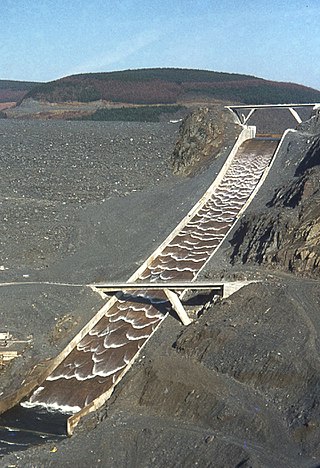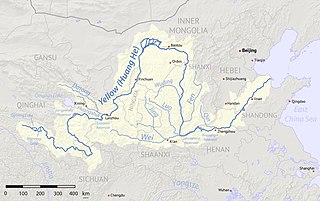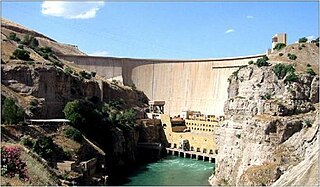Related Research Articles

Hydropower, also known as water power, is the use of falling or fast-running water to produce electricity or to power machines. This is achieved by converting the gravitational potential or kinetic energy of a water source to produce power. Hydropower is a method of sustainable energy production. Hydropower is now used principally for hydroelectric power generation, and is also applied as one half of an energy storage system known as pumped-storage hydroelectricity.

A dam is a barrier that stops or restricts the flow of surface water or underground streams. Reservoirs created by dams not only suppress floods but also provide water for activities such as irrigation, human consumption, industrial use, aquaculture, and navigability. Hydropower is often used in conjunction with dams to generate electricity. A dam can also be used to collect or store water which can be evenly distributed between locations. Dams generally serve the primary purpose of retaining water, while other structures such as floodgates or levees are used to manage or prevent water flow into specific land regions.

The Three Gorges Dam is a hydroelectric gravity dam that spans the Yangtze River near the Sandouping, in Yiling District, Yichang, Hubei province, central China, downstream of the Three Gorges. The world's largest power station in terms of installed capacity (22,500 MW), the Three Gorges Dam generates 95±20 TWh of electricity per year on average, depending on the amount of precipitation in the river basin. After the extensive monsoon rainfalls of 2020, the dam's annual production reached nearly 112 TWh, breaking the previous world record of ~103 TWh set by Itaipu Dam in 2016.

Hydroelectricity, or hydroelectric power, is electricity generated from hydropower. Hydropower supplies one sixth of the world's electricity, almost 4500 TWh in 2020, which is more than all other renewable sources combined and also more than nuclear power. Hydropower can provide large amounts of low-carbon electricity on demand, making it a key element for creating secure and clean electricity supply systems. A hydroelectric power station that has a dam and reservoir is a flexible source, since the amount of electricity produced can be increased or decreased in seconds or minutes in response to varying electricity demand. Once a hydroelectric complex is constructed, it produces no direct waste, and almost always emits considerably less greenhouse gas than fossil fuel-powered energy plants. However, when constructed in lowland rainforest areas, where part of the forest is inundated, substantial amounts of greenhouse gases may be emitted.

Hydraulic engineering as a sub-discipline of civil engineering is concerned with the flow and conveyance of fluids, principally water and sewage. One feature of these systems is the extensive use of gravity as the motive force to cause the movement of the fluids. This area of civil engineering is intimately related to the design of bridges, dams, channels, canals, and levees, and to both sanitary and environmental engineering.

A spillway is a structure used to provide the controlled release of water downstream from a dam or levee, typically into the riverbed of the dammed river itself. In the United Kingdom, they may be known as overflow channels. Spillways ensure that water does not damage parts of the structure not designed to convey water.
The Banqiao Reservoir Dam is a dam on the River Ru (汝河), a tributary of the Hong River in Zhumadian City, Henan province, China. The Banqiao dam and Shimantan Reservoir Dam are among 62 dams in Zhumadian that failed catastrophically in 1975 during Typhoon Nina. The dam was subsequently rebuilt.

Qiandao Lake is a man-made freshwater lake located in Chun'an County, Hangzhou, Zhejiang Province, China, that was formed after the completion of the Xin'an River hydroelectric station in 1959.

The Fen River drains the center of Shanxi Province, China. It originates in the Guancen Mountains of Ningwu County in northeast Shanxi, flows southeast into the basin of Taiyuan, and then south through the central valley of Shanxi before turning west to join the Yellow River west of Hejin. The Fen and the Wei Rivers are the two largest tributaries of the Yellow River. The river is 694 kilometers (431 mi) long and drains an area of 39,417 km2 (15,219 sq mi), 25.3% of Shanxi's area. The Fen River is the longest in Shanxi. It is also the second-longest tributary of the Yellow River. Within Taiyuan, the Fen runs from north to south; the prefecture includes one-seventh of the river's course.

A reservoir is an enlarged lake behind a dam. Such a dam may be either artificial, usually built to store fresh water, or it may be a natural formation.

Nagarjuna Sagar Dam is a masonry dam across the Krishna River at Nagarjuna Sagar which straddles the border between Palnadu district in Andhra Pradesh and Nalgonda district in Telangana. The dam provides irrigation water to the districts of Palnadu, Guntur, Nalgonda, Prakasam, Khammam, Krishna, and parts of West Godavari. It is also a source of electricity generation for the national grid.

The Haditha Dam or Qadisiya Dam is an earth-fill dam on the Euphrates, north of Haditha (Iraq), creating Lake Qadisiyah. The dam is just over 9 kilometres (5.6 mi) long and 57 metres (187 ft) high. The purpose of the dam is to generate hydroelectricity, regulate the flow of the Euphrates and provide water for irrigation. It is the second-largest hydroelectric contributor to the power system in Iraq behind the Mosul Dam.

The South–North Water Transfer Project, also translated as the South-to-North Water Diversion Project is a multidecade infrastructure mega-project in China that ultimately aims to channel 44.8 cubic kilometers of fresh water each year from the Yangtze River in southern China to the more arid and industrialized north through three canal systems:

The environmental impact of reservoirs comes under ever-increasing scrutiny as the global demand for water and energy increases and the number and size of reservoirs increases.

A dam failure or dam burst is a catastrophic type of structural failure characterized by the sudden, rapid, and uncontrolled release of impounded water or the likelihood of such an uncontrolled release. Between the years 2000 and 2009 more than 200 notable dam failures happened worldwide.

The Dukan Dam is a multi-purpose concrete arch dam in As Sulaymaniyah Governorate, Kurdistan Region of Iraq. It impounds the Little Zab, thereby creating Lake Dukan. The Dukan Dam was built between 1954 and 1959 whereas its power station became fully operational in 1979. The dam is 360 metres (1,180 ft) long and 116.5 metres (382 ft) high and its hydroelectric power station has a maximum capacity of 400 MW.

Çamlıdere Dam is a dam in Turkey. The basin measures 753.4 km2 and is the primary source of drinkable water source for the city of Ankara.

Woodhead Dam is a dam on Table Mountain, Western Cape, South Africa. It was built in 1897 and supplies water to Cape Town. The dam, which was the first large masonry dam in South Africa, was designated as an International Historic Civil Engineering Landmark by the American Society of Civil Engineers in 2008.

The Bhumibol Dam is a concrete arch dam on the Ping River, a tributary of the Chao Phraya River, in Sam Ngao District of Tak Province, Thailand. It is about 480 km (298 mi) north of Bangkok and was built for the purposes of water storage, hydroelectric power production, flood control, fisheries and saltwater intrusion management. The dam was named after King Bhumibol Adulyadej and it was Thailand's first multi-purpose project. It is the highest dam in Thailand at 154 m (505 ft) tall.
References
- ↑ DAM CONSTRUCTION AND MANAGEMENT IN CHINA (PDF). MINISTRY OF WATER RESOURCES, PEOPLE'S REPUBLIC OF CHINA. Archived from the original (PDF) on 2022-07-10. Retrieved 2021-11-14.
- ↑ CROWELL, WILLIAM GORDON (2014). "Tradition and History: Quebei, Sunshu Ao, and The Persistence of a Narrative". Asia Major. 27 (1): 33–71. ISSN 0004-4482. JSTOR 26571267 . Retrieved 2021-11-14.
- 1 2 Viollet, P. L. (2017). Water Engineering in Ancient Civilizations: 5,000 Years of History. CRC Press. ISBN 978-0-203-37531-0.
- ↑ Goff, Craig; Atyeo, Matthew; Petkovsek, Gregor; Roca, Marta; Kitamura, Yuichi (2020-11-20). "The origins of large dam engineering and factors contributing to dam longevity". Dams and Reservoirs. 30 (3): 97–104. doi:10.1680/jdare.20.00017. S2CID 225008682 . Retrieved 2021-11-14.
32°17′30″N116°40′58″E / 32.29167°N 116.68278°E